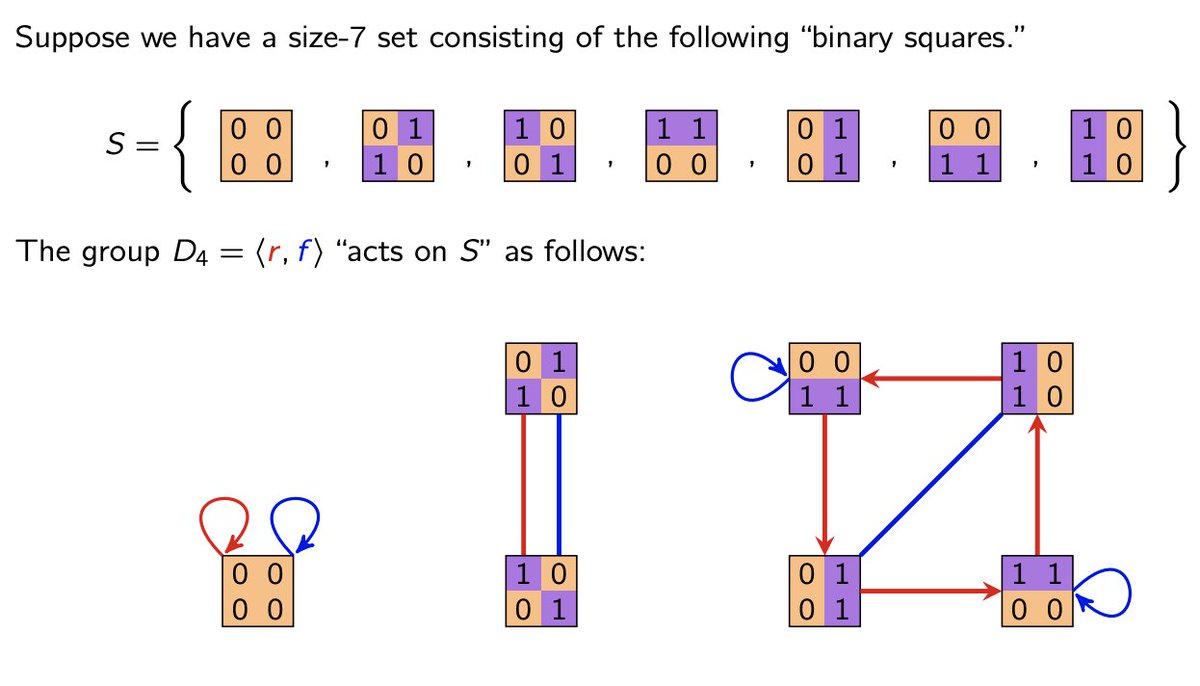
Now that my #VisualAlgebra class is in the books, I want to post a long "meta thread" of all 16 weekly threads, with daily summaries. Here's my entire class, including lectures, HW, & exams, in one convenient place.
And stayed tuned for some surprise announcements below!👇🧵
And stayed tuned for some surprise announcements below!👇🧵

We started #Week1 of #VisualAlgebra with a few quotes from "A Mathematician's Apology" on the beauty of mathematics, and then saw Cayley diagrams for the symmetries of the rectangle and triangle.
https://twitter.com/VisualAlgebra/status/1482065699212120064
In #Week2 of #VisualAlgebra, we explored the Rubik's cube, more Cayley diagrams, group presentations, the impossibility of the word & halting problems, and we classified all frieze groups.
https://twitter.com/VisualAlgebra/status/1484052959637954563
In #Week3 of #VisualAlgebra, we saw wallpaper & crystal groups, Cayley tables, quotients (informally). We saw some non-Cayley diagrams and tables (Latin squares), formalized the definition of a group, and saw cyclic & dihedral groups, and cycle diagrams.
https://twitter.com/VisualAlgebra/status/1485822465913892875
In #Week4 of #VisualAlgebra, we classified finitely generated abelian groups, learned about permutations, and the symmetric & alternating groups, and saw many of their Cayley diagrams on beautifully laid out on Archimedean solids.
https://twitter.com/VisualAlgebra/status/1488271745266057216
In #Week5 of #VisualAlgebra, we learned about some "uncommon" groups that we used throughout the semester: dicyclic, diquaternion, semidihedral, semiabelian. We also saw how to construct semidirect products of cyclic groups using Cayley diagrams.
https://twitter.com/VisualAlgebra/status/1490920027738218496
We started #Week6 of #VisualAlgebra with groups of matrices, the Hamitonians, and a discussion of the classification of finite groups. Then we moved into subgroups & their lattices, cosets, and normal subgroups.
https://twitter.com/VisualAlgebra/status/1493336860797521924
We started #Week7 of #VisualAlgebra with the tower law & normalizers. Then non-standard concepts: degree of normality, fully vs. moderately unnormal subgroups, and unicorns. Then conjugate subgroups and quotients, and well-definedness.
https://twitter.com/VisualAlgebra/status/1496349786659864577
We started #Week8 of #VisualAlgebra with conjugacy classes of elements, and how "conjugacy preserves structure", and introduced "reduced subgroups lattices". We took a day off for #Midterm1.
https://twitter.com/VisualAlgebra/status/1498529051463532546
We started #Week9 of #VisualAlgebra with conjugacy in S_n, and introduced the idea of "degree of centrality", and ended it with homomorphisms -- embedding & quotients, and finally, the fundamental homomorphism (1st isomorphism) theorem.
https://twitter.com/VisualAlgebra/status/1501062418767695874
We covered the last 3 isomorphism theorems (correspondence, diamond, freshman) in #Week10 of #VisualAlgebra, then saw commutators, abelizations, automorphisms (inner and outer), and semidirect products.
https://twitter.com/VisualAlgebra/status/1503563931608133635
We finished semidirect products in #Week11 of #VisualAlgebra. Then came group actions & "5 fundamental features: orbits, stabilizers, fixed point sets, kernel, global fixed points. We proved the orb-stab & orbit counting theorems & explored many examples.
https://twitter.com/VisualAlgebra/status/1508648981374640136
We saw more examples of actions in #Week12 of #VisualAlgebra: groups acting on themselves, subgroups, & cosets. We used this to prove structure theorems. Actions of automorphisms, action equivalence, and we began Sylow theory.
https://twitter.com/VisualAlgebra/status/1511165622822096900
What I did NOT do in #Week12 of #VisualAlgebra was to classify ALL transitive actions. I didn't actually realize how simple and elegant this was until after class ended. Next semester, I will include this material.
Bonus:
Bonus:
https://twitter.com/VisualAlgebra/status/1525279383379918853
We finished Sylow theory in #Week13 of #VisualAlgebra, and saw how to show that there are no simple groups of order n, for certain n. Then we moved onto rings, saw LOTS of examples, and ended with ideals.
https://twitter.com/VisualAlgebra/status/1513727470821851136
We began #Week14 of #VisualAlgebra with quotient rings, and then saw the isomorphism theorems. Then, maximal ideals, quotient fields, finite fields, and prime ideals. With #Midterm2 in the middle.
https://twitter.com/VisualAlgebra/status/1516191101203496965
The last week of #VisualAlgebra lectures was #Week15: divisibility, factorization, & rings of algebraic integers. Primes, irreducibles, PIDs (and gcd & lcm), Euclidean domains, all that jazz. We finished with some open questions and some pretty pictures.
https://twitter.com/VisualAlgebra/status/1519165820605448192
I guess finals week counts as #Week16 of #VisualAlgebra, and here's what our final exam looked like.
And now, as promised, onto some fun announcements! 👇
1/6
https://twitter.com/VisualAlgebra/status/1522680930539778048
And now, as promised, onto some fun announcements! 👇
1/6
I'll teach #VisualAlgebra2 in #Spring2023, pending enrollment! And yes, I'll tweet daily summaries for that class too! Topics will include more ring theory, solvable & nilpotent groups, universal properties, free groups, presentations, field & Galois theory.
But FIRST....
2/6
But FIRST....
2/6
I'll teach #GraduateVisualAlgebra in #Fall2022! Yes, our 1st semester grad algebra course can be visual. I'm not 100% sure how it'll go, but LOTS of basic proofs will be left as exercises (show __ is a subgroup, etc). And, I will be tweeting this course as well. Stay tuned!
3/6
3/6
I am finishing up my #VisualAlgebra textbook this summer, and I'm really excited how it's turning out! I will (eventually) be making all of my slides, including LaTeX files & images, freely available. For now, you can view my course materials here:
math.clemson.edu/~macaule/math4…
4/6
math.clemson.edu/~macaule/math4…
4/6
I'll be recording a brand new set of #VisualAlgebra #YouTube videos, covering basically my whole book (both semesters). Don't watch my old ones -- these will be MUCH better! And with professional audio equipment. (Shout out to @mathflipped for the help!)
5/6
5/6
Finally, as you can tell, I'm very passionate about these ideas, and love seeing others enjoy them. Please spread the word! On here or otherwise. If you're interested in teaching like this, I'm happy to share materials and/or meet over Zoom. Don't hesitate to get in touch!
6/6
6/6
• • •
Missing some Tweet in this thread? You can try to
force a refresh



























